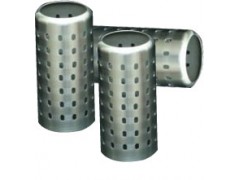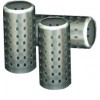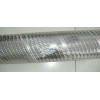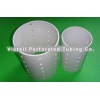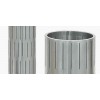Aluminum perforated tube is extremely useful at low-temperatures. At subzero temperatures its strength increases while retaining ductility. At temperatures over 400F aluminum alloy sheets tend to lose some of their strength.
Aluminum, like Stainless Steel, is corrosion resistant. It is, however, much lighter and softer than Stainless and Carbon Steel. To prevent the dull appearance that results from the oxidation of the outer layer, Aluminum can be either clear or color anodized after perforating. Unlike paint or powder coating, anodize film is built from the aluminum itself and takes on a translucent appearance. The alloys listed below are categorized into two types, non-heat-treatable and heat-treatable.
Commonly Perforated Aluminum Types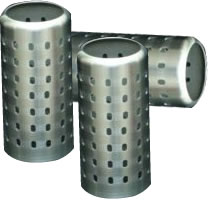
1100 (Non-Heat-Treatable Alloys)
This commercially pure, low-strength alloy has excellent corrosion resistance and satisfactory anodizing and coating finishes. It is unmatched by any other commercial aluminum alloy in workability.
3003 (Non-Heat-Treatable Alloys)
The most widely used general-purpose alloy because of its good corrosion resistance, moderate strength, formability, and weldability. This alloy may show some slight discoloration when anodized, but reacts well to other coating finishes.
5005 (Non-Heat-Treatable Alloys)
Comparable to 3003 in strength and formability, this alloy has superior finishing characteristics, making it much better for anodizing. Excellent corrosion resistance and weldability, but rates below 1100 and 3003 for machining.
5052 (Non-Heat-Treatable Alloys)
A versatile high-strength alloy with good forming characteristics and excellent corrosion resistance. Although easily welded, it is not recommended for brazing and soldering applications. Anodized coatings may take on a yellowish tint if applied too thick.
2024 (Heat-Treatable Alloys)
An age hardening, high-strength alloy with nearly twice the strength of 5052 and fair corrosion resistance. Alclad 2024 provides improved corrosion resistance. Anodized coatings may take on a yellowish tint if applied too thick.
6061 (Heat-Treatable Alloys)
A high-strength alloy that has very good corrosion resistant, finishing, welding characteristics. Anodized coatings may take on a yellowish tint if applied too thick.
7075 (Heat-Treatable Alloys)
Developed for aircraft applications, this is one of the highest strength, commercially available alloys. It has fair corrosion resistance and machinability. Alclad 7075 provides improved corrosion resistance. Anodized coatings may take on a yellowish tint if applied too thick.
| Aluminum | Lbs. Per Square Foot | |||||||||
|---|---|---|---|---|---|---|---|---|---|---|
| Gauge | Mean of Gauge | Min. of Gauge | Max. of Gauge | 1100 | 3003 | 5005 | 5052 | 2024 | 6061 | 7075 |
| 1 | .249 | .238 | .260 | 3.52 | 3.56 | 3.52 | 3.49 | 3.60 | 3.53 | 3.623 |
| 4 | .190 | .181 | .199 | 2.69 | 2.71 | 2.69 | 2.65 | 2.77 | 2.69 | 2.763 |
| 6 | .160 | .152 | .168 | 2.27 | 2.28 | 2.27 | 2.23 | 2.32 | 2.25 | 2.327 |
| 8 | .125 | .120 | .130 | 1.76 | 1.78 | 1.76 | 1.75 | 1.82 | 1.76 | 1.818 |
| 10 | .100 | .095 | .105 | 1.41 | 1.43 | 1.41 | 1.40 | 1.45 | 1.41 | 1.454 |
| 11 | .090 | .086 | .094 | 1.27 | 1.28 | 1.27 | 1.26 | 1.31 | 1.27 | 1.309 |
| 12 | .080 | .076 | .084 | 1.13 | 1.14 | 1.13 | 1.12 | 1.16 | 1.13 | 1.164 |
| 14 | .063 | .059 | .067 | .889 | .898 | .889 | .880 | .916 | .889 | .916 |
| 16 | .050 | .046 | .054 | .706 | .713 | .706 | .698 | .727 | .706 | .727 |
| 18 | .040 | .037 | .043 | .564 | .570 | .564 | .559 | .582 | .564 | .582 |
| 20 | .032 | .0295 | .0345 | .452 | .456 | .452 | .447 | .466 | .452 | .465 |
| 22 | .025 | .0225 | .0275 | .353 | .356 | .353 | .349 | .364 | .353 | .364 |
| 24 | .020 | .0175 | .0225 | .282 | .285 | .282 | .279 | .291 | .282 | .291 |
| 26 | .016 | .014 | .018 | .226 | .228 | .226 | - | .232 | - | - |
| 28 | .012 | .010 | .014 | .169 | - | .169 | - | - | - | - |


